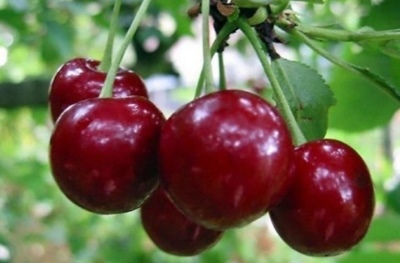
- Appeared when crossing: Griot Ostheim x Novodvorskaya
- Barrel type: wood
- Growth type: vigorous
- Crown: pyramidal, raised, medium density
- Flowering and fruiting type: on bouquet branches
- Fruit size: large
- Fruit shape: rounded
- Fruit color: dark red
- Fruit weight, g: 5,7
- Pulp color : Dark red
Various varieties of cherries are produced every decade. Breeders cross certain species to achieve the desired result. A good crop should have a high yield, good low temperature tolerance, and immunity to a number of diseases. Cherry Griot Belorussian is a hybrid that many will like due to its unique characteristics.
Breeding history
The variety appeared when crossing Griot Ostgeimsky and Novodvorskaya cherries. Since 2004, it has been on variety trials. It has not yet been included in the State Register for the Russian Federation, but it is recommended for subsequent breeding in nurseries, plantations and for private cultivation.
The Griot variety itself has its roots in Turkey. And the species came to us approximately in the 50-60s of the last century. It was at this time on the territory of the USSR that new varieties of culture were actively developed for subsequent reproduction throughout the territory of the Soviets.
There are quite a few varieties that originated from Turkish cherry. Mainly because one of the ingredients is the Griot Ostheim cherry.
In addition to Griot Belorussky cherries, you can find the following Griot varieties.
Melitopol. Dominates on the territory of Ukraine, since the culture was created by a Ukrainian breeder.
Moscow. One of the most popular types of this selection in Russia.
Rossoshansky.
Michurinsky.
Description of the variety
The tree is vigorous, but reaches a height of only 2-3 m. The crown is of medium thickening. If several cherry trees are planted too close to each other, then their tops will intertwine over time, which visually increases the density. The crown resembles a pyramid in shape. At the bottom, the branches go more to the side, and the higher the branch, the more it tends upward.
Leaves are medium in size, there are quite a few of them, arranged in pairs or in a chaotic manner. The color is green, matte. Too strong sunlight may curl the leaf plate slightly.
Peduncles are most often formed in small bouquet branches. But in the variety, you can sometimes find single buds.
Growers note good taste data, yield, as well as excellent transportability of berries over long distances.
After harvest, the fruits are stored in a dark, cool and dry place for up to 10 days. If you pick slightly unripe berries, then their shelf life can increase to 14-18 days. For better storage, you should not wash the cherries.
Fruit characteristics
The berries are large, round in shape. Their mass reaches 5-7 g. In the center, where the stalk is attached, there is a small depression. The skin is glossy, with a slight bloom, dark red in color. The longer a berry ripens on a branch, the darker and softer it becomes.
The pulp is of medium density, very juicy and tender. The color of the pulp is dark red. A medium-sized seed is formed inside; it is easily removed from the berry.
The variety belongs to the universal, so the fruits can be eaten fresh, juices, preserves, jams, mashed potatoes, jellies can be prepared from them. Berries tolerate freezing well and do not lose their external and taste characteristics.
Taste qualities
Gardeners note the exquisite and refined sweet taste of Griot Belorussky cherries. The longer the berries ripen, the softer and sweeter they become. Sour taste predominates in fruits harvested ahead of time. The cherry tasting score is also on top - 4.8 points.
Ripening and fruiting
The first harvest falls on 4 years after planting, which classifies the crop as early-growing. Ripening period is average. Flowering occurs in late May - early June, and lasts up to two weeks. Fruiting is slightly extended, falls on the 2-3 decade of July. Although the berries are formed almost simultaneously, they ripen gradually.

Yield
Cherry has a high yield, on average up to 17 tons per hectare. From one tree remove from 7 to 10 kg of berries. Much depends on the region and weather conditions.
Self-fertility and the need for pollinators
The culture belongs to the self-infertile type, therefore it needs additional pollination. For this, it is recommended to plant pollinator varieties at a distance of 2-3 m.
Vianok cherry is suitable for pollination. He has the same timing of the beginning of flowering. And you can also plant the varieties Volochaevka and Novodvorskaya.
Landing
Health and good fertility largely depend on the place where the cherry will grow. It is necessary to choose a place with neutral soil so that it is well lit by the sun. In this case, a strong draft should be avoided.
You can plant cherries in autumn and spring. When planting a plant, you should be guided by a 5x3 m planting scheme.
After planting, the trunk must be tied to a support. Spill the ground around with 2 buckets of water.


Growing and care
The main care is as follows.
Normalized watering. Cherry will not only have enough groundwater and rain, especially in dry summers.
Top dressing must be carried out for 2-3 years of life.
Pruning of dry branches is carried out 2 times a year.
For the winter, the trunk should be whitewashed to the first lower branches. Only young seedlings need to be covered.


































































